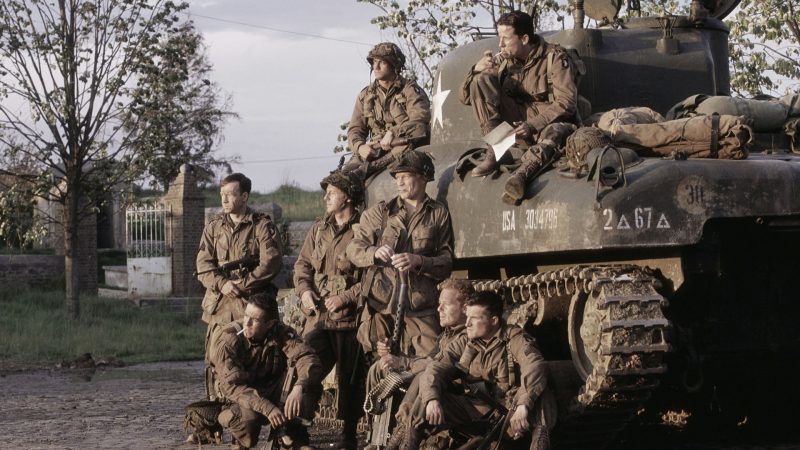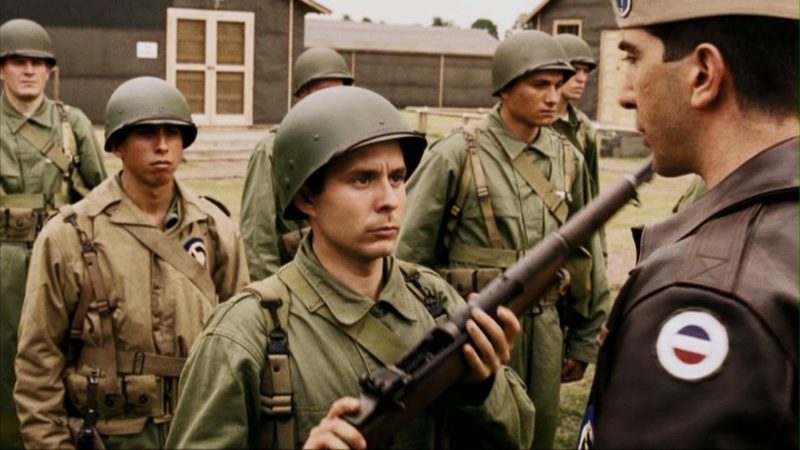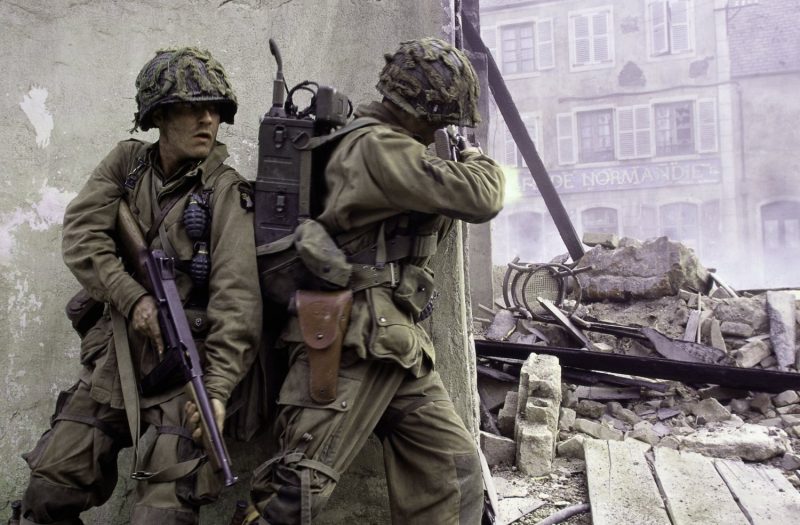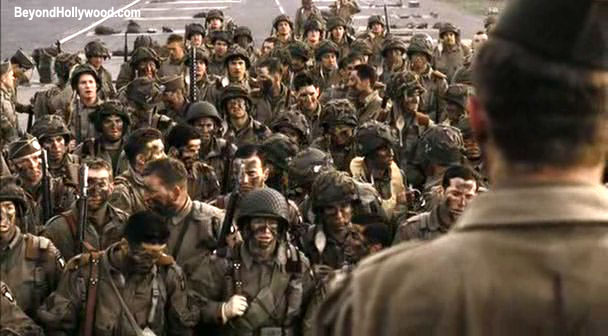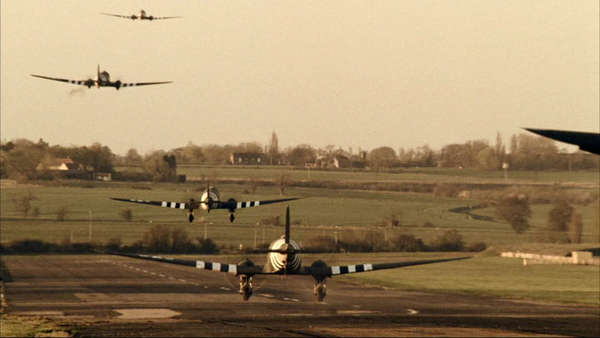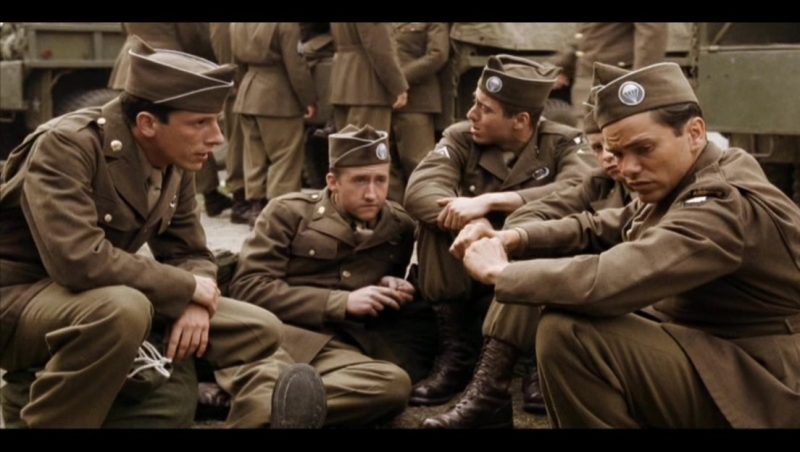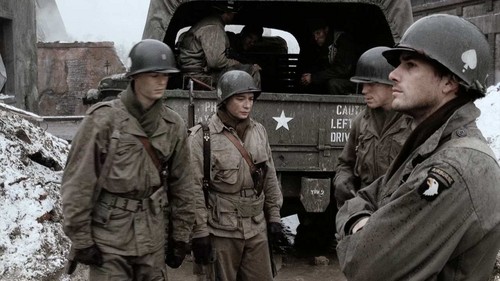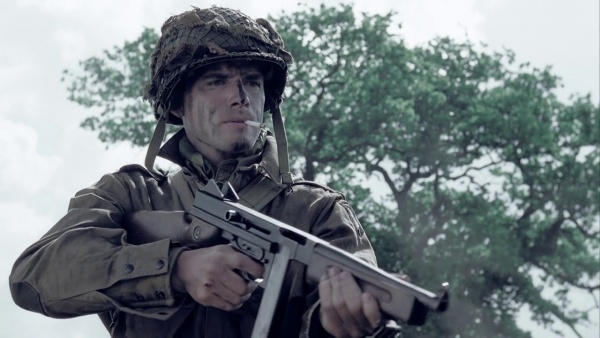OK – just for some Sunday fun. Without doubt the series that turned the WWII hobby around and really put it on the map. If it wasn’t for such a series as Band of Brothers than a vast majority of reenactors, kit suppliers, magazines, websites and authors wouldn’t be here to day. There are those that ‘mock’ such ‘movies’ as Band of Brothers but again, and perhaps ironically, these type of folks were only introduced to our WWII history because of a series like this.
BoB is now 14 years old and still a master piece for so many. We have watched it more times than we care to remember and here we have 30 ‘mistakes’ that you more than likely have scene (see what we have done there???)!
1. According to Parachute Infantry: An American Paratrooper’s Memoir of D-Day and the Fall of the Third Reich, Richard Winters was promoted to Major before David Webster returned to Easy Company from the hospital after getting injured in Holland. However, in “The Last Patrol”, Winters was still Captain until he received his promotion at the end of the episode.
2. Towards the end, Lt. Winters is walking along a road as a column of vehicles pass. As a Tank passes, he salutes using his left hand. In military protocol, it is considered a sign of disrespect to salute with the left hand.
3. At the beginning of the ninth episode, “Why We Fight”, the date says April 11, 1945 as the episode opens with the paratroopers overlooking German civilians cleaning up their streets. At the end of the episode, the show returns to this scene, at which point Captain Nixon tells the others that Hitler had killed himself. However Hitler did not kill himself until April 30, 1945.
4. At the end of the final episode, “Points,” it is stated that Technician Fifth Class Joseph Liebgott became a San Francisco taxi driver after the war, but most accounts, including that of his son, state that Joseph Liebgott in fact became a barber after returning home from the war.
5. The series states that Easy Company was the first unit into Berchtesgaden and the Eagle’s Nest, capturing the town and surrounding area without incident. Historians usually identify the first Allied troops to arrive as the U.S. 3rd Infantry Division who secured Berchtesgaden and the Berghof, followed four days later by the French 2nd Armored Division who secured the Eagle’s Nest, then 1st Battalion of the 506th, led by Company “C.” This, however, may be incorrect. The 2nd Battalion of the 506th came into Berchtesgaden by a different route and lost men in a skirmish with the crews of two German 88 mm guns. Controversy has come up in recent years as to precisely which unit captured Berchtesgaden, but in the book Beyond Band of Brothers, Major Dick Winters states “Major General John W. ‘Iron Mike’ O’Daniel’s 3rd Infantry Division certainly seized neighboring Salzburg without opposition and may have had their lead elements enter Berchtesgaden before we (2nd Battalion, 506 PIR) arrived in force, but let the facts speak for themselves. If the 3rd Division was first into Berchtesgaden, where did they go? Berchtesgaden is a relatively small community. When I walked into the Berchtesgaden Hof with Lieutenant Welsh, neither of us saw anyone except the hotel staff. Goering’s officers’ club and wine cellar certainly would have drawn the attention of a Frenchman from LeClerc’s 2nd Armored Division or a rifleman from the 3rd Division. I find it inconceivable to imagine that if the 3rd Division were there first, they left those beautiful Mercedes staff cars untouched for our men.”
6. In the final episode, “Points”, Major Winters accepts the surrender of a German Colonel, who offers him an ornate Luger pistol. In the scene, Winters tells him to keep his sidearm, but in the Bonus Features DVD, the real Winters recalls the incident and shows the pistol (a Walther PP) he accepted. In Ambrose’s book of the same title, he describes how when Winters examined the firearm, he found it had never been fired, and he hasn’t fired it since. He shows this firearm in the HBO documentary We Stand Alone Together. Also in book Beyond Band of Brothers : The war memoirs of Major Dick Winters written by Cole. C. Kingseed with Major Dick Winters it is said that the pistol was accepted but the rank of the German soldier was a Major not Colonel.
7. In the third episode “Carentan” at the counter-attack, we can clearly see a Jagdpanther with the counter-attacking German forces, however the only Jagdpanthers in the area were in the German 654th Heavy Antitank Battalion and only saw combat in the late Battle of Normandy against British units.
8. When Easy is paddling across the river to aid the British soldiers, there is a shot where the person closest to the camera (Bull Randleman) appears to be rowing, but there is nothing in his hands.
9. The end of episode three states that Albert Blithe never recovered from the wounds he received in Normandy, and that he died in 1948. Fellow Easy Company Currahee veterans interviewed while writing the mini-series Band of Brothers had thought that Blithe did not recover from his wounds, which they mistakenly recalled as a neck wound (in actuality he was shot in the right shoulder), and had died in Philadelphia in 1948. Albert Blithe remained on active duty, was awarded the Silver Star for gallantry in combat, served in the Korean War and achieved the rank of Master Sergeant, married with two children. He died in December 1967 of complications of surgery for a perforated ulcer after attending a memorial ceremony in Bastogne and was buried in Arlington National Cemetery with full military honors.
10. At the beginning when they show Meehan explaining that they’re not going to jump because of fog, he is using his hands to emphasize the point, when they go back to the same point near the end of the episode, Meehan has his hands behind his back.
11. When Heffron is taking his throw at darts, he states that he needs a “double seven”. When he takes the throw, the dart goes into the treble eight (an earlier close-up confirms that the board has the standard Gamlin configuration), yet, from the reaction he gets, he’s made the throw he was going for.
12. The door keeps changing positions in the scene where Sobel is punishing Winters for failing to inspect the latrine.
13. In the scene at the end of Part 1 where the aircraft are taking off on June 5 1944, as the camera pulls out to show the many aircraft rolling down the tarmac, the first aircraft shows the pilot wearing a pale green headset remarkably similar to a David Clark headset. However, the Clark company didn’t start producing headsets until after the war.
14. When Bull is wounded and crawling through the trench to avoid being run over by the tank, he looks back after the telephone pole comes down and you can see the camera crew in the upper right corner.
15. In the credits, Ross McCall’s character’s name is misspelled as “Joesph” D. Liebgott.
16. In part 5 when Easy company surprises the two sleeping German companies, with Winters leading the charge. Winters crosses the berm and a sleeping German stands up, and gets shot. Winters then shoots off 9 more rounds (2 too many), then reloads, drops to one knee and only shoots 6 rounds (2 too few), and in both cases the clip ejects as if it were a normal 8 round firing
17. David Webster is shown to be training as part of Easy Company and is present among their number when Lt Meehan informs them that the invasion has been postponed. Webster actually trained with Fox Company and made the jump into Normandy as a member of the Battalion Headquarters Company. He transferred to Easy Company after D-Day.
18. The British paratroop commander is a brigadier-general. The British Army abolished the rank of brigadier-general in 1922 and replaced it with brigadier in 1928. A brigadier is not a general and does not wear a general officer’s cap badge.
19. When Cpt. Nixon is running out of booze while he is playing poker with some other officers he is going out to take a walk. After a while he stops in front of a shop window and smashes a petrol can from a nearby jeep through the glass. There is a big hole in the window but not big enough for him to get through. Two shots later there is no glass at all in the shop window even though he never had the time to remove the rest of it.
20. In Currahee when they are crawling through pig guts Muck goes through and gets blood on his leg from a hanging gut yet the guy behind him goes through the same area and has no blood on his leg.
21. In “Currahee”, Robert Strayer is (correctly) wearing the rank insignia of a major when Easy Company is celebrating its paratrooper qualification. Strayer was promoted to lieutenant colonel in January or February of 1943, and Winters refers to him as such during his explanation to Sobel about the latrine inspection incident. On D-Day (in episode 2) just prior to the attack on the 105mm guns at Brecourt Manor, Winters and another officer refer to Strayer as a major. He had been an LTC long enough (16 or 17 months) to rule out a slip of the tongue, especially by two different officers.
22. When the 101st Airborne was sent into Belgium just before the Battle of the Bulge they were ordered to remove the Screaming Eagle patch from their uniforms, so the Germans would not know they were facing an elite division. It was only after the battle when they moved into Hagenau that they were able to wear the patches again.
23. In, “Points”, when Easy Company first enters Berchtesgarden, the first shot showing the white flags, on the left, in a first-floor window, you can see someone with a handycam/miniDV shooting the actual film crew and cast.
24. At Lt Meehan’s map briefing for Normandy, Carentan was given as one of the objectives. Although that town was certainly alluded to in those briefings, it was not yet an objective of the 101st. That was decided several days after the jump, when Carentan was added to the agenda of 101st objectives. This was unforseen, which was why BG Max Taylor was able to make his “Give me 3 days and nights of hard fighting and you’ll be relieved and sent back to England” speech prior to D-Day. (Trigger Time)
25. The invasion message sheets from Colonel Sink shown in the series, which were handed out at the airfield were twice the size of actual ones, which were the same size as Ike’s Great Crusade message.(Trigger Time)
26. Another fault as to insignia in Episode 1 was the white name tapes worn by officers and EM alike in England. I have NEVER seen a period photo showing ANYONE in 506th wearing white name tapes. The practice in the 506th was to stencil names in black ink directly onto the chest of an M42 jacket. (there are two vintage examples in my collection). Ample evidence of that is shown in the many photos in the 506th regimental history book ‘Currahee’, with a couple of officers wearing their names stenciled on an OD#3 name tag. White name tapes WERE worn (mostly by officers) in the 502 and 377th PFA Bn as evidenced by period photos. (Trigger Time) 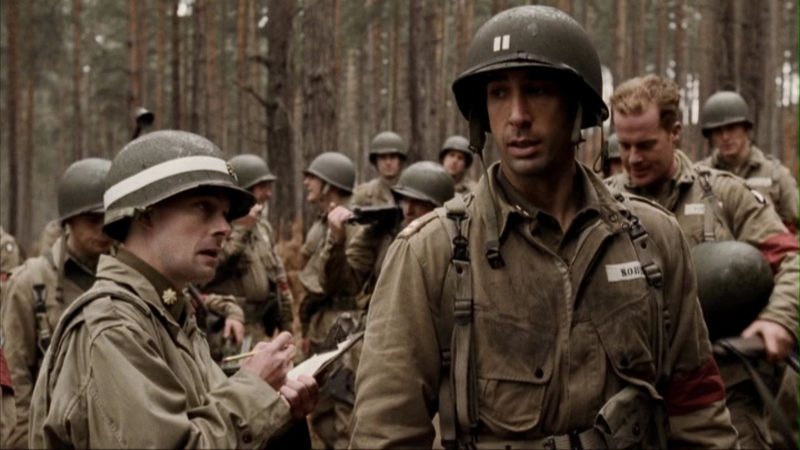
27. Regarding the ending of Episode 2 on D-Day night in St Marie du Mont, Winters actually spent that night about 2 or 3 miles southwest of St Marie, at Culloville, where Colonel Sink’s HQ was located. There is no picturesque river or lake at either of those locations. (Trigger Time)
28. Before that scene, several men are shown recalling events of D-Day, with visualized flashbacks of Lt Speirs and the infamous cigarette incident. Although that allegedly happened on D-Day (in the film) and we saw that the PoW victims were regular German Army troops, suddenly in this visualization, the victims become mostly Waffen SS troops. There were no Waffen SS troops in contact with the 101st on D-Day, and the men talking about Speirs didn’t learn what a combat SS uniform looked like until later that day (June 12th) at the earliest. Just wondering why the substitution of German troop types for that visualization? Was this to make the audience more sympathetic to Speirs ? (Trigger Time)
29. The same night, when Blithe encountered Lt Speirs on his implied ghoulish nocturnal sortie, the passwords used are obsolete. The entire First Army, not just the paratroopers, changed passwords every three days, starting one day after D-Day. Flash-Thunder was only used on D-Day. From D+ 1 thru 3, the words changed to Thirsty-Victory. From D+3 thru 6, to Weapon-Throat; from D plus 6 thru 9, to Wool-Rabbit. So in scenes such as the meeting with an ‘F’ company member above Carentan, as well as the Blithe-Speirs encounter, the passwords should have changed accordingly. They could have gotten this info from me also, but probably consider it “unimportant”. (Trigger Time)
30. Also in that scene, Lt Speirs tells Blithe that there’s no hope and to accept the fact that he’s already dead, Mr Speirs has stated via his stepson, that he himself never made such a comment. (Trigger Time)
